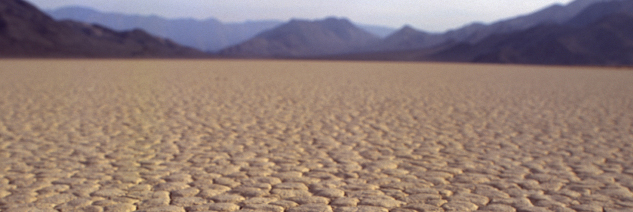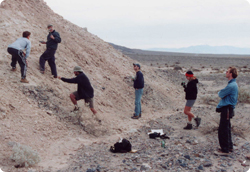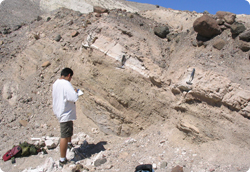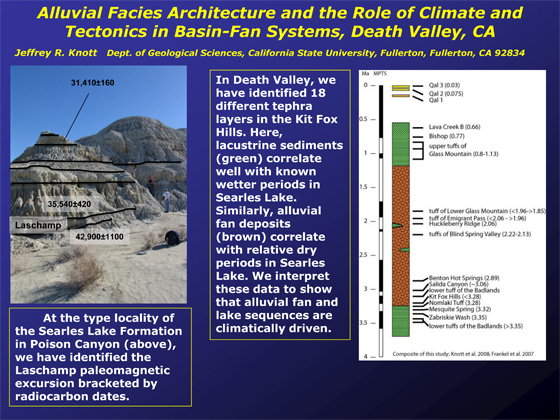
Death Valley Basin-Fan Systems
J.R. Knott, PhDCalifornia State University Fullerton
Alluvial Facies Architecture and the Role of Climate and Tectonics in Basin-Fan Systems, Death Valley, California
J.R. Knott, PhDCalifornia State University Fullerton Members of Dr. Knott’s research team, including from left to right, Jeff Hathaway, Joseph Liddicoat, Jim Palomino, field assistant, Veva Ebbs andChris Pluhar collecting paleomagnetic samples of sediments in the Kit Fox Hills of Death Valley.
Members of Dr. Knott’s research team, including from left to right, Jeff Hathaway, Joseph Liddicoat, Jim Palomino, field assistant, Veva Ebbs andChris Pluhar collecting paleomagnetic samples of sediments in the Kit Fox Hills of Death Valley.
“I did my PhD work in Death Valley, and one of the things that always surprised me was how little we really knew about its evolution,” says Dr. Knott. Using funds from the Petroleum Research Fund, Dr. Knott turned that early fascination into research reconstructing how Death Valley has evolved over the past three and a half million years. His work focuses on facies architecture in pull-apart basins, which is the relative distribution of fine-grained lake deposits vs. course-grained alluvial-fan deposits, and the common structural features found in strike-slip regimes, which have significant petroleum potential. Death Valley is an ideal environment in which to study alluvial fans and pull-apart basins because of its lack of vegetation, excellent exposures, and the presence of a nearby tectonically inactive basin (Searles Valley) with a well-preserved paleoclimate record.
Dr. Knott’s research uses analysis of volcanic ash beds to determine the age of the rocks and the shape of the landscape known as tephrochronology. Volcanic ash is deposited within a day or a week—for geologists, that’s an instant in time. Death Valley includes ash beds from a variety of different sources including Yellowstone, Long Valley, and the two volcanic sources in Northern California (the Cascade Mountains and the Sonoma Volcanic field). Each ash bed has its own chemical composition or “fingerprint.” By identifying ash beds in different locations (e.g., lake beds or gravel pits), geologists can reconstruct what the landscape looked like at the time the ash was deposited. Focusing on the last 4 million years, Dr. Knott’s team has found over 30 different volcanic ash beds at nearly 100 locations. The result is a Rosetta Stone of sorts that allows Dr. Knott and his team to reconstruct the landscape’s evolution and gather a good view of paleoclimate changes pre-industrial revolution and over millions of years.
 Brian David describing the >3.58 million year old Curry Canyon tuff (1-foot-thick white bed where hammers are) interbedded with alluvial fan deposits near Zabriskie Point.
Brian David describing the >3.58 million year old Curry Canyon tuff (1-foot-thick white bed where hammers are) interbedded with alluvial fan deposits near Zabriskie Point.
Most people look at a landscape today and think that the mountains and basins have always been as they are. According to Dr. Knott, “What we find in Death Valley is that in the last three million years, the landscape isn’t stagnant; it’s rapidly changing. So the mountains are growing and basins are shrinking and vice versa, as the faults grow and develop.” As mountains are pushed apart due to plate tectonics, they move along particular faults, which often originate in or along the base of each mountain. These faults delineate the boundary between mountain and basin. Dr. Knott’s team is finding that over time, new faults evolve that cut through the middle of and dividing these basins and generating new mountains in what previously had been basins.
The pull-apart basins, like Death Valley, result in gravelly deposits that hold fluids between the particles deposited there making them excellent oil and water reservoirs. As scientists understand more about how these basins evolve over time, they gain a better understanding of how to extract the oil contained within. When applied to the geometry of oil fields formed in extended crust, like the North Sea, this sequencing of the development of basins in Death Valley is leading to the discovery of additional petroleum reservoirs increasing production efficiency. From the work in Death Valley, Dr. Knott’s team has begun working with oil companies fingerprinting volcanic ashes pulled from core samples in active oil fields. This process helps determine the characteristics and geometry of reservoirs being explored, leading to more efficient oil production.

Knott’s research has also had a significant impact on his career. He credits receiving the grant with being a key aspect of his receiving tenure at his institution. The grant has impacted his students as well. In total, 8 undergraduates and 4 graduate students participated in research related to this project. Five undergraduates are pursuing or completed graduate study and all others are working as professional geologists.




